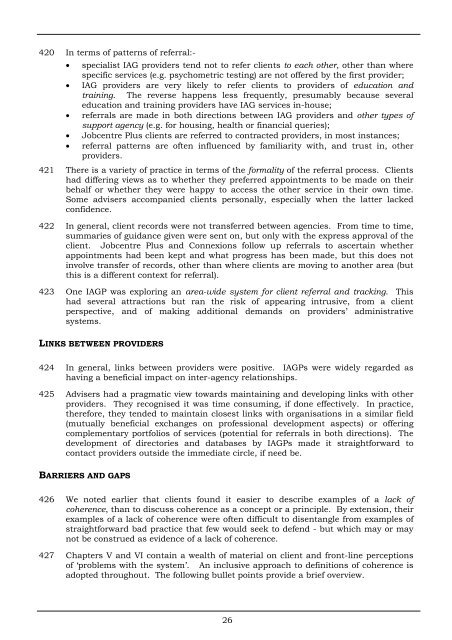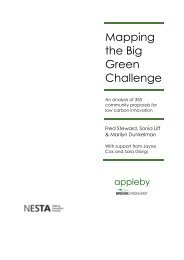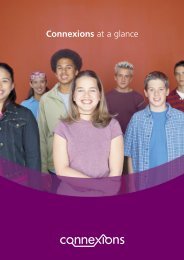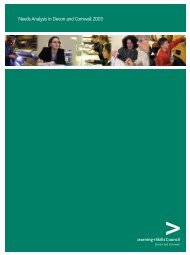Client needs for coherent information, advice and guidance services ...
Client needs for coherent information, advice and guidance services ...
Client needs for coherent information, advice and guidance services ...
Create successful ePaper yourself
Turn your PDF publications into a flip-book with our unique Google optimized e-Paper software.
420 In terms of patterns of referral:-<br />
• specialist IAG providers tend not to refer clients to each other, other than where<br />
specific <strong>services</strong> (e.g. psychometric testing) are not offered by the first provider;<br />
• IAG providers are very likely to refer clients to providers of education <strong>and</strong><br />
training. The reverse happens less frequently, presumably because several<br />
education <strong>and</strong> training providers have IAG <strong>services</strong> in-house;<br />
• referrals are made in both directions between IAG providers <strong>and</strong> other types of<br />
support agency (e.g. <strong>for</strong> housing, health or financial queries);<br />
• Jobcentre Plus clients are referred to contracted providers, in most instances;<br />
• referral patterns are often influenced by familiarity with, <strong>and</strong> trust in, other<br />
providers.<br />
421 There is a variety of practice in terms of the <strong>for</strong>mality of the referral process. <strong>Client</strong>s<br />
had differing views as to whether they preferred appointments to be made on their<br />
behalf or whether they were happy to access the other service in their own time.<br />
Some advisers accompanied clients personally, especially when the latter lacked<br />
confidence.<br />
422 In general, client records were not transferred between agencies. From time to time,<br />
summaries of <strong>guidance</strong> given were sent on, but only with the express approval of the<br />
client. Jobcentre Plus <strong>and</strong> Connexions follow up referrals to ascertain whether<br />
appointments had been kept <strong>and</strong> what progress has been made, but this does not<br />
involve transfer of records, other than where clients are moving to another area (but<br />
this is a different context <strong>for</strong> referral).<br />
423 One IAGP was exploring an area-wide system <strong>for</strong> client referral <strong>and</strong> tracking. This<br />
had several attractions but ran the risk of appearing intrusive, from a client<br />
perspective, <strong>and</strong> of making additional dem<strong>and</strong>s on providers’ administrative<br />
systems.<br />
LINKS BETWEEN PROVIDERS<br />
424 In general, links between providers were positive. IAGPs were widely regarded as<br />
having a beneficial impact on inter-agency relationships.<br />
425 Advisers had a pragmatic view towards maintaining <strong>and</strong> developing links with other<br />
providers. They recognised it was time consuming, if done effectively. In practice,<br />
there<strong>for</strong>e, they tended to maintain closest links with organisations in a similar field<br />
(mutually beneficial exchanges on professional development aspects) or offering<br />
complementary portfolios of <strong>services</strong> (potential <strong>for</strong> referrals in both directions). The<br />
development of directories <strong>and</strong> databases by IAGPs made it straight<strong>for</strong>ward to<br />
contact providers outside the immediate circle, if need be.<br />
BARRIERS AND GAPS<br />
426 We noted earlier that clients found it easier to describe examples of a lack of<br />
coherence, than to discuss coherence as a concept or a principle. By extension, their<br />
examples of a lack of coherence were often difficult to disentangle from examples of<br />
straight<strong>for</strong>ward bad practice that few would seek to defend - but which may or may<br />
not be construed as evidence of a lack of coherence.<br />
427 Chapters V <strong>and</strong> VI contain a wealth of material on client <strong>and</strong> front-line perceptions<br />
of ‘problems with the system’. An inclusive approach to definitions of coherence is<br />
adopted throughout. The following bullet points provide a brief overview.<br />
26











